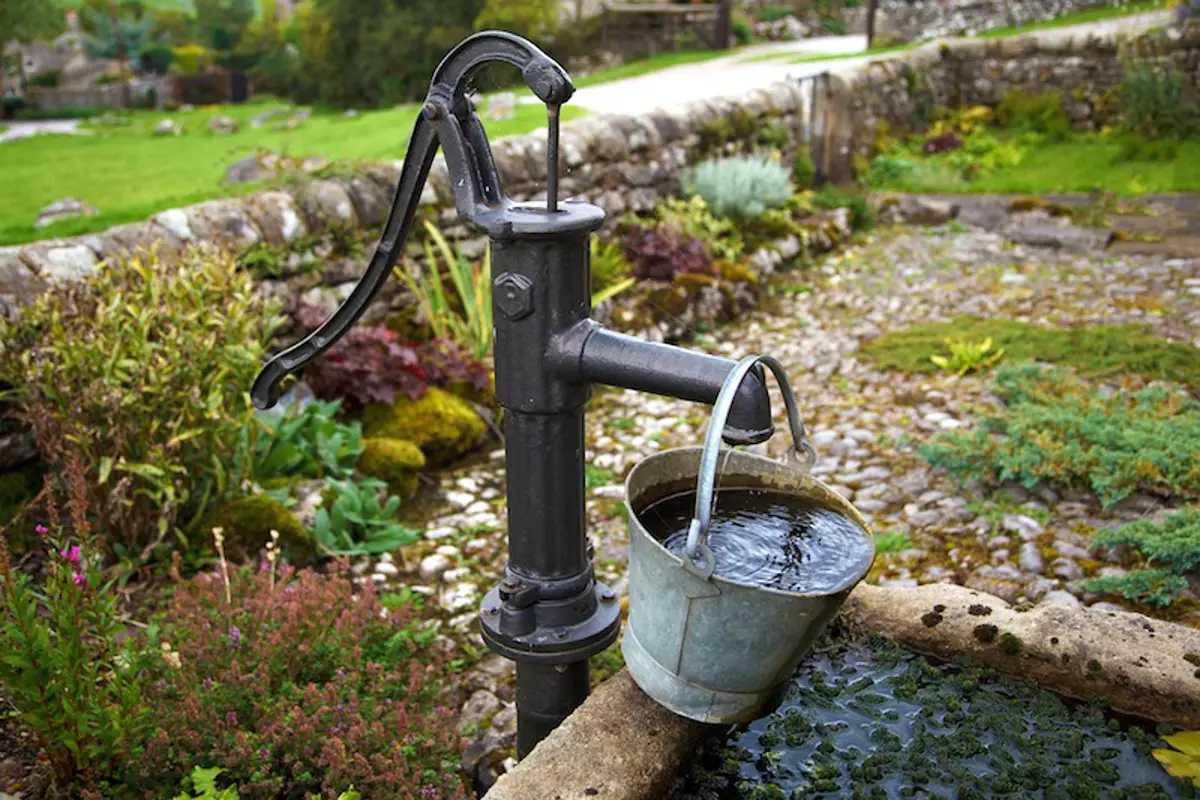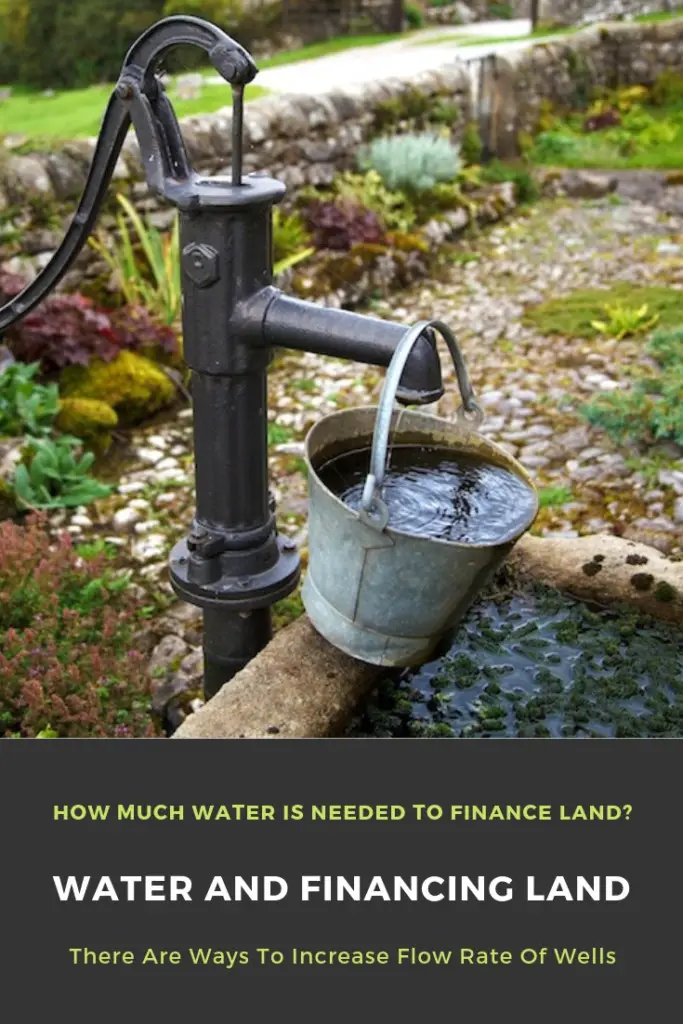In working with people to help them find their dream Country or Homestead property I am asked many questions.
One of the common questions people ask is about water and financing land.
How much water is needed to finance land?
The usual minimum requirement for conventional financing is 5 gallons per minute well flow.
In some situations, you may be able to finance with less flow.
However, 5 gallons per minute may not be sufficient to meet your needs.
With some lenders it may be possible to finance land that has a lesser flow of water from a well.
There is a way to increase the flow rate of many wells.
Possible Ways of Financing Property With Less Than A 5 Gallon Flow Rate of Well Water
First, if you have a property with a well that produces between 3 and 5 gallons/minute you may be able to obtain financing through a Farm Home Loan Agency or a County Agricultural Program.
It does not hurt to ask.
That said, it may not be easy to find financing.
In some cases if you install an underground tank holding 1000 gallons or more of water that is filled up overnight, that may make financing through non-conventional means possible.
In most cases, with less than 5 gallons/minute flow of water available, the only method of financing could be some variation of owner carry back financing.
With a buried tank holding water in reserve you need to be aware of how quickly that tank can be emptied when in use.
I know of more than one person who had a buried tank of at least 1000 gallons who placed a sprinkler in the garden and forgot to turn it off when they made a trip into town.
Upon returning home they found that the tank had been emptied.
In another case where the flow rate was less than 1 gallon per minute, the pump had nearly burned itself out trying to fill the tank with water that was not available!
In some specific instances it may be possible to combine a well’s output with the output of a good spring to be able to obtain financing from a Farm Loan Agency, County Agricultural Program.
Or a local small town bank that has a mortgage division.
It does not hurt to ask around.
Water Is The Most Important Factor When Purchasing Land
The availability of water is the most important factor to consider when looking for land!
Everything else is of secondary importance.
If there is not enough water for the homestead’s daily use such as for a garden, stock animals you might want to raise, a few fruit trees and berry bushes and perhaps a flower garden, the land you are looking at is not suitable for a Country or Homestead property.
You can estimate the amount of water needed for a homestead in an article I wrote titled, “Daily Homestead Water Needs (Determining Amounts Necessary).”
Depending on how much water you need, a 5 gallon/minute well might not be a sufficient amount of water.
A 5 gallon/minute flow rate from a well is the usual minimum well output for conventional financing of land.
To have a successful homestead usually requires a higher flow rate from a well.
If you currently own land that has a well with less than sufficient water for your needs, the well’s output may be improved by Hydrofracking the well.
This procedure, where water and in some instances, sand is injected into the well under pressure can improve a well’s flow.
The purpose of Hydrofracking is to fracture the rock in the water bearing stratem.
This can double the flow of water (the recharge rate) into the well giving sufficient water for the needs of a homestead.
Do not confuse the process of Hydrofracking a water well with Fracking of an oil or natural gas well.
The basic procedure is the same.
Since the depth of water wells are much less that oil or natural gas wells hydrofracking of a water well does not have the potential to cause the problems that Fracking an oil or natural gas well may cause.
Owner Financing Land With Less Than 3-5 Gallons Per Minute Flow
If the land does not qualify for financing because the flow of water is too low, the only way to finance the land may be by Owner Financing.
“Owner Financing Explained⎮What To Include And Avoid” is an article I wrote about a topic that must be understood.
If you are considering purchasing property with less than a 3-5 gallon flow of water per minute.
Not all owners of land for sale are interested in financing the sale of land they have on the market.
There are two methods of Owner Financing that are very risky for the Buyer.
And should be avoided if at all possible.
They are called a “Land Sale Contract”.
And a “Contract for Deed.”
In these two methods of Owner Financing the Buyer does not get a deed to the property.
Until every payment has been made.
Without a deed to the property the buyer has no legal proof of an ownership interest in the land.
Legally the land is still the Sellers.
And if there is any disagreement between Buyer and Seller the Seller can have the Buyer removed from the property!
Without a deed showing an ownership interest in the land, the best the Buyer can hope for is to sue the Seller/Owner.
For a return of some of the payments made and part of the value of any improvements the Buyer made on the land.
The Buyer can not sue for the land because he has no legal proof of an ownership interest in the land!
Any Owner Financing should include a deed given the Buyer at Closing.
There should also be safe guards in the financing documents allowing for a 5 day grace period before a payment is late.
And a 3 month period of time to catch up on missed payments before the Seller can foreclose and get the land back.
The Difference Between Flow Rate And Sufficiency of Water
Flow rate refers to how much water the well can produce after an hour of continuous pumping of water out of the well.
It depends on the recharge rate of water flowing into the well after it has been pumped continuously for at least an hour.
There is a tendency, even among Real Estate Professionals, to multiply the flow rate per minute by the minutes in a day to decide if there is sufficient water for needs.
That is not the way to determine if there is sufficient water for your needs!
You must look at the water usage from a practical standpoint!
Let me give you an example.
- It is August and it hasn’t rained for a month. Your in the middle of a hot spell with temperatures in the mid-nineties for days and occasionally going into triple digits.
- The lawn is a mixture of dust and dead grass. You’re concerned with keeping the garden, berry bushes and orchard watered plus having enough flow rate to fill the water troughs for stock.
- There is the water demand from daily family needs.
- The garden, berry bushes and orchard need watering in the early morning or late evening to be ready for that day’s or the next day’s heat.
- The stock’s watering troughs are on automatic floats that when the level goes down a certain amount the trough automatically refills.
- In the heat of the day, it is best if everyone reduces the work outside so most work is done early morning or late evening.
This creates a situation where water usage is not able to be spread over an entire day.
And there are periods of peak water usage that can easily exceed a 5 gallon per minute flow rate of a well.
There are drip systems or soaker hoses watering the berry bushes, sprinklers in the garden and hoses watering the orchard.
The toilets fill slowly after flushing and the water in the kitchen only comes out in a very small stream as mom is preparing breakfast or washing dishes.
Depending on how big the garden, berry bushes patch and orchard is and how many devices are needed to get them watered before the heat of the day, a 10 gallon flow per minute well can be taxed to the limit.
Remember, a 5 gallon flow per minute well is the usual minimum for being able to finance land.
It is not always sufficient as a source of water in the hot dry summer days when it is water the garden or lose an entire years worth of produce.
When you read “How Can Insufficient Homestead Water Supply Be Improved?”, an article that I wrote, you can become an expert in ways to increase water availability on the homestead.
Should Land Without A Source of Water Be Purchased
If there is not a proven source of sufficient water on the land before you purchase it, proceed with caution!
There is no guarantee that a well can be drilled on that land that will produce water sufficient for conventional financing and your daily homestead water needs.
Even the most experienced Well Drillers drill a dry hole from time to time.
The average percentage across America for experienced Well Drillers failing to hit water when they drill is 15% of the time.
This means that more than one hopeful homesteader has been left with property that has become the site of a dry hole.
After all the funds for a well were exhausted.
If a well driller does not hit water, you still pay for the drilling!
A sufficient source of water for homestead needs can be a combination of water from a well, spring or year round stream.
Provided that you have the rights to the water from all those sources.
Combining these sources can give you sufficient water for the homesteads needs.
But may not qualify for conventional financing of the property.
Without a known and proven sufficient source of water present on the property before you purchase the land, it is best to look elsewhere for Country or Homestead Property!
Related Questions
What State has the cheapest land per acre?
That depends on who you use as a source.
The cheapest land per acre will probably not be land suitable for a homestead.
It will not have the 5 Key Factors which include; good soil, enough water, a good amount of sunlight and the best growing season.
I discuss these 5 key factors in an article I wrote, “Choosing Homestead Property – Water, Soil, Trees, Location”
Land in a desert might have a lot of sunshine and 9 months of growing season, but does it have enough water?
It only takes the insufficiency of one of the 4 factors mentioned above to make cheap land worthless for a homestead.
Do banks give loans for land?
Yes, if all the right conditions are present.
Usually banks do not loan more than 50% of the Appraised Value of raw or undeveloped land.
If you defaulted on the loan, the bank will want to get it’s money back.
So a loan on undeveloped land is possible but there are limits to how much of the land’s value the bank will loan money on.
Can you get money to buy land and build a house?
You can get money to buy land as set out in the question above.
You can get money to build a house, it is called a Construction Loan.
However, the usual requirement for a Construction Loan is to have the land owned free and clear.
The bank puts a lien on the land to secure the construction loan.
Once the house is built you get what is sometimes called a “Take Out Loan” which takes out, pays off, the Construction Loan.
This loan is also called a mortgage and is for a period of years at a certain interest rate.


